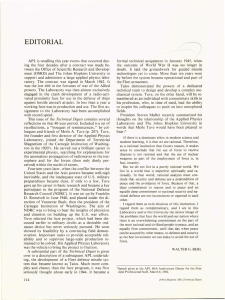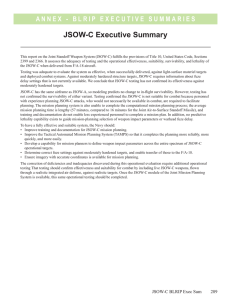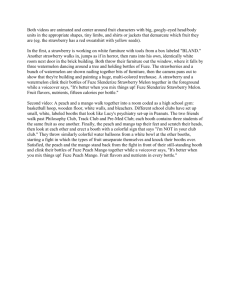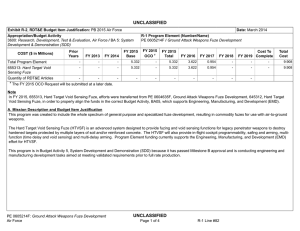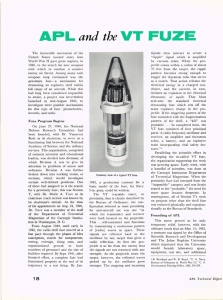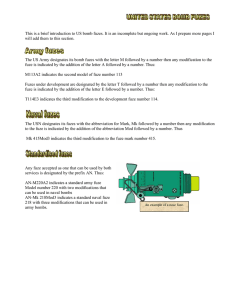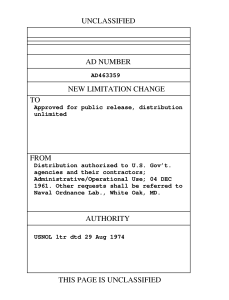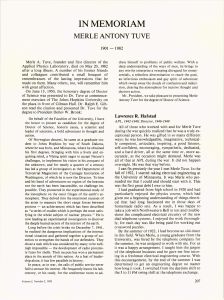THE DEVELOPMENT OF THE RADIO PROXIMITY FUZE
advertisement
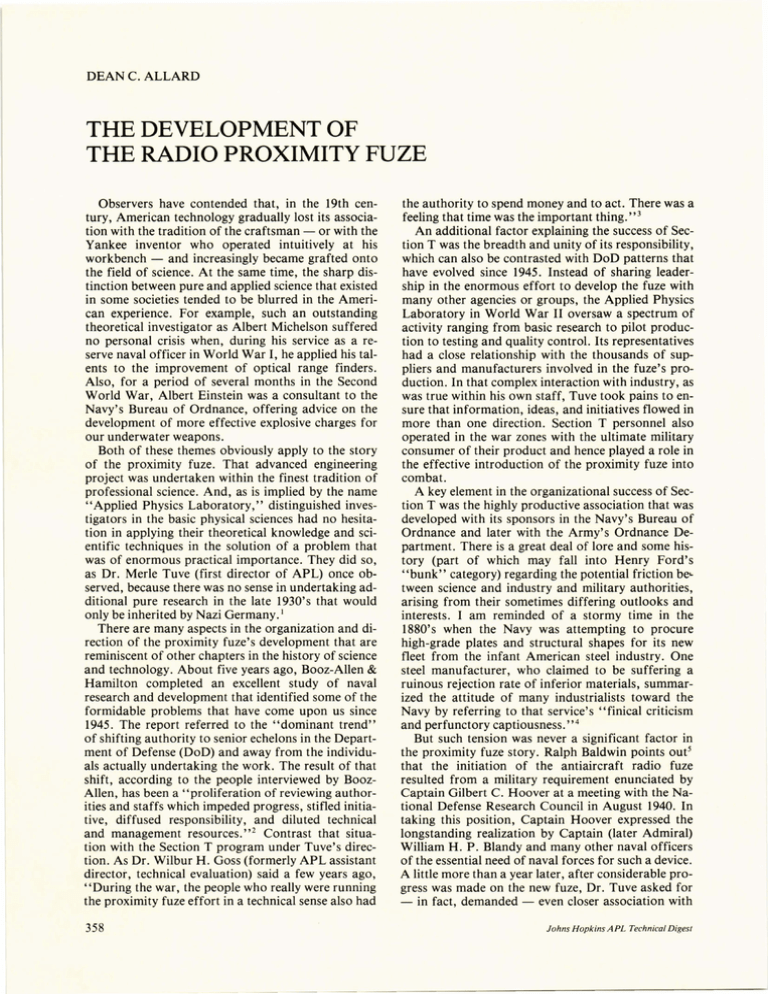
DEAN C. ALLARD THE DEVELOPMENT OF THE RADIO PROXIMITY FUZE Observers have contended that, in the 19th century, American technology gradually lost its association with the tradition of the craftsman -- or with the Yankee inventor who operated intuitively at his workbench -- and increasingly became grafted onto the field of science. At the same time, the sharp distinction between pure and applied science that existed in some societies tended to be blurred in the American experience. For example, such an outstanding theoretical investigator as Albert Michelson suffered no personal crisis when, during his service as a reserve naval officer in World War I, he applied his talents to the improvement of optical range finders. Also, for a period of several months in the Second World War, Albert Einstein was a consultant to the Navy's Bureau of Ordnance, offering advice on the development of more effective explosive charges for our underwater weapons. Both of these themes obviously apply to the story of the proximity fuze. That advanced engineering project was undertaken within the finest tradition of professional science. And, as is implied by the name "Applied Physics Laboratory," distinguished investigators in the basic physical sciences had no hesitation in applying their theoretical knowledge and scientific techniques in the solution of a problem that was of enormous practical importance. They did so, as Dr. Merle Tuve (first director of APL) once observed, because there was no sense in undertaking additional pure research in the late 1930' s that would only be inherited by Nazi Germany.l There are many aspects in the organization and direction of the proximity fuze's development that are reminiscent of other chapters in the history of science and technology. About five years ago, Booz-Allen & Hamilton completed an excellent study of naval research and development that identified some of the formidable problems that have come upon us since 1945. The report referred to the "dominant trend" of shifting authority to senior echelons in the Department of Defense (DoD) and away from the individuals actually undertaking the work. The result of that shift, according to the people interviewed by BoozAllen, has been a "proliferation of reviewing authorities and staffs which impeded progress, stifled initiative, diffused responsibility, and diluted technical and management resources.,,2 Contrast that situation with the Section T program under Tuve's direction. As Dr. Wilbur H. Goss (formerly APL assistant director, technical evaluation) said a few years ago, "During the war, the people who really were running the proximity fuze effort in a technical sense also had 358 the authority to spend money and to act. There was a feeling that time was the important thing.,,3 An additional factor explaining the success of Section T was the breadth and unity of its responsibility, which can also be contrasted with DoD patterns that have evolved since 1945. Instead of sharing leadership in the enormous effort to develop the fuze with many other agencies or groups, the Applied Physics Laboratory in World War II oversaw a spectrum of activity ranging from basic research to pilot production to testing and quality control. Its representatives had a close relationship with the thousands of suppliers and manufacturers involved in the fuze's production. In that complex interaction with industry, as was true within his own staff, Tuve took pains to ensure that information, ideas, and initiatives flowed in more than one direction. Section T personnel also operated in the war zones with the ultimate military consumer of their product and hence played a role in the effective introduction of the proximity fuze into combat. A key element in the organizational success of Section T was the highly productive association that was developed with its sponsors in the Navy's Bureau of Ordnance and later with the Army's Ordnance Department. There is a great deal of lore and some history (part of which may fall into Henry Ford's "bunk" category) regarding the potential friction bel. tween science and industry and military authorities, arising from their sometimes differing outlooks and interests. I am reminded of a stormy time in the 1880' s when the Navy was attempting to procure high-grade plates and structural shapes for its new fleet from the infant American steel industry. One steel manufacturer, who claimed to be suffering a ruinous rejection rate of inferior materials, summarized the attitude of many industrialists toward the Navy by referring to that service's "finical criticism and perfunctory captiousness.,,4 But such tension was never a significant factor in the proximity fuze story. Ralph Baldwin points out 5 that the initiation of the antiaircraft radio fuze resulted from a military requirement enunciated by Captain Gilbert C. Hoover at a meeting with the National Defense Research Council in August 1940. In taking this position, Captain Hoover expressed the longstanding realization by Captain (later Admiral) William H. P. Blandy and many other naval officers of the essential need of naval forces for such a device. A little more than a year later, after considerable progress was made on the new fuze, Dr. Tuve asked for -- in fact, demanded -- even closer association with Johns Hopkins APL Technical Digest the American military. Specifically, in September 1941, Tuve requested "constant and unsolicited" counsel by experienced uniformed officers, noting that it was only in this way that the staff of Section T could receive "foresight." He added these very blunt words: "It is absurd to expect civilians with no experience whatever to anticipate every difficulty and every requirement for such a new weapon as the Radio Fuse. It is hardly fair to the officers of Section T to leave the entire responsibility for initiative and foresight regarding future difficulties and delays entirely in their hands. The Services should share this responsibility with us, instead of being simply available 'on call' ." 1 The key naval representative who came forth in the early stages of Section T was none other than Commander (later Rear Admiral) William S. Parsons. Tuve noted that it was Parsons who was the "direct channel to the best technical people in the Navy" and that his participation in every detail of the work "gave everybody confidence that this wasn't just a silly exercise invented by some civilians."2 Tuve also pointed out Parson's superb technical qualifications as well as his thorough professional knowledge of tactical naval requirements. This valuable combination later led Parsons to join with Section T personnel in ensuring the effective introduction of the fuze into the Fleet, including the initial and highly successful battle use of the weapon by the cruiser USS Helena in January 1943. Admiral Blandy was Chief of the Bureau of Ordnance from 1941 to 1943. He was succeeded by Admiral G. F. Hussey, who went out on a limb to the tune of $85 million for the first production contract for the proximity fuze. As a naval historian, I pause to comment that Parsons, Blandy, and Hussey, together with such leaders in the tactical employment of the fuze as Admirals Arleigh A. Burke and Edwin B. Hooper and many other important figures, had all received postgraduate education in ordnance engineering early in their naval careers. Later they served in the Bureau of Ordnance and similar organizations, but they typically had alternate tours as line officers with the Fleet. As a result, those technically oriented men were never isolated for long from the real needs of the seagoing Navy. Certainly, this system of ord- Volume 3, Number 4, 1982 nance postgraduate training was one of the principal reasons for the success of naval/scientific relationships in the proximity fuze program. It may be useful to contrast Section T's results with the limited success of the Germans in so many technical areas during World War II. Baldwin and Tuve have made it clear that Germany's problem did not result from a lack of scientific and technical competence. 6 Instead, that country's essential difficulty resulted from the failure to develop a successful organization and pattern of leadership similar to those enjoyed by the proximity fuze program. Rather than consolidating an important project under the leadership of such men as Tuve, 'there often was a fragmentation among competing groups. Typically, German scientists lacked the sense of urgency that was found in the United States. To some extent, that leisurely attitude resulted from the failure of Germany's military leaders to define military requirements clearly or to participate in the same intimate sense as happened at APL. The authoritarian organization of German institutions discouraged the initiative and advancement of ideas from below that were demanded at the Applied Physics Laboratory. For these and other reasons it was very difficult for German industrial firms to cooperate with each other and with the government - another notable contrast with the development of the American proximity fuze. In the last analysis, and despite the totalitarian philosophy of the Nazis, the failings of so many scientific and industrial organizations in Germany reflected that country's inability to fully commit its society and economy to the war effort. Ironically, it was left to the aroused American and British democracies to achieve a much greater level of scientific, social, economic, and industrial mobilization. REFERENCES and NOTES 1Interview with Merle A. Tuve by Al Christman, Naval Ordnance Test Station, China Lake, Calif. (May 1967). 2Booz-Allen & Hamilton, Inc., "Review of Navy Rand D Management, 1946-1973, Summary," 59-60(1976). 3Interview with Wilbur H. Goss and Henry H. Porter by Al Christman, Naval Ordnance Test Station, China Lake, Calif. (May 1967). 4D. C. Allard, The Influence of the United States Navy Upon the American Steel Industry, 1880-1900, unpublished Master's thesis, Georgetown University (1959). 5R. B. Baldwin, The Deadly Fuze: The Secret Weapon of World War /I, Presidio Press , San Rafael, Calif. (1980) . 359
